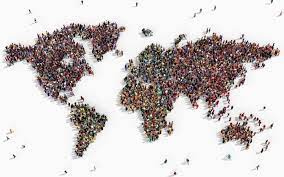One of the biggest problems of countries today is the population issue. While Europe’s greatest need is for the young population, the excess of the elderly population creates future concerns. Besides, if we look at the whole world, the human population is on the steps of 8 billion. Of course, there are certain good and bad benefits to this.
If we consider the population issue in terms of the first humans, we will understand how important the number of humans was for our future at that time. In the first periods when we struggled with disease and death, the continuity of our generation was ensured by the large population, so our extinction did not go extinct. When it comes to the middle ages, which can be considered close, although the deaths caused by the plague epidemic that swept across Europe put the future of humanity in great danger, our species was saved from extinction due to the increasing population. In the first and second world wars, which we can count as the two biggest black spots in the history of humanity, our species came back from the edge of the abyss as more than 100 million people died. The real thing that saves the future of our species from many more dangers like this is population growth. So why has population growth, which has sustained our lives for centuries, become a problem in today’s world?

Let’s imagine a house together. While four people are living happily in this house, suddenly the doorbell rings and four more people enter. Imagine that the number of people entering the house increases exponentially as the days go by. In addition, the area of the house does not increase in any way. Likewise, food production, which is a vital element, does not increase. As a result, the people of the house will not be able to fit in here, and worse, people will die because the food will not be enough for everyone. As we will see here, the population of our world has grown uncontrollably in a period of about two centuries, including the industrial revolution. The reason for this is actually quite logical when the conditions of the period are evaluated. Namely, the prevalence of postpartum deaths in ancient times was a threat to the continuation of our lives. For this reason, the number of children in families at that time was generally 7-8 people. Of course, there were some problems that this caused in the society apart from the population. The biggest example was the alienation of women from society. Thanks to women who have made great sacrifices for the continuation of our generation, we have actually come to these days. Because they were forced into the role of babysitting by giving up their work and their own economic freedom, of course, forced by outsiders. Thanks to their sacrifice, the danger has passed a little.

As in the home example, the human population continued to increase uncontrollably at the end of the 20th century and at the beginning of the 21st century. In addition to this, humanity, which has been struggling with many problems such as economic crises and food crises, has recently managed to control the population. The food problem not only persists today, but also poses a threat to the future. Nature, which is more damaged due to increased energy consumption as a result of unplanned urbanization, is trying to get rid of us. The natural disasters that have increased in recent times show once again that we, as humanity, could not go beyond a burden on the world’s shoulders. As painful as this is, we don’t have time to be sad. As quickly as possible, humankind has to find a permanent solution to the world and population problem. Otherwise, we have come to the end that has been avoided for centuries, and if we are late, there will be no return from here.
